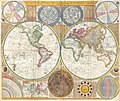Súbor:1794 Samuel Dunn Wall Map of the World in Hemispheres - Geographicus - World2-dunn-1794.jpg

Veľkosť tohto náhľadu: 712 × 600 pixelov. Iné rozlíšenia: 285 × 240 pixelov | 570 × 480 pixelov | 912 × 768 pixelov | 1 216 × 1 024 pixelov | 2 431 × 2 048 pixelov | 6 000 × 5 054 pixelov .
Pôvodný súbor (6 000 × 5 054 pixelov, veľkosť súboru: 8,92 MB, MIME typ: image/jpeg)
História súboru
Po kliknutí na dátum/čas uvidíte ako súbor vyzeral vtedy.
| Dátum/Čas | Náhľad | Rozmery | Používateľ | Komentár | |
|---|---|---|---|---|---|
| aktuálna | 20:01, 1. jún 2012 |  | 6 000 × 5 054 (8,92 MB) | Brandmeister~commonswiki | Reverted to version as of 04:17, 23 March 2011 |
| 16:15, 19. máj 2012 |  | 6 000 × 5 054 (27,38 MB) | Brandmeister~commonswiki | contrast | |
| 04:17, 23. marec 2011 |  | 6 000 × 5 054 (8,92 MB) | BotMultichillT | {{subst:User:Multichill/Geographicus |link=http://www.geographicus.com/P/AntiqueMap/World2-dunn-1794 |product_name=1794 Samuel Dunn Wall Map of the World in Hemispheres |map_title=A General Map of the World, or Terraqueouis Globe with all the New Discover |
Použitie súboru
Na tento súbor odkazujú nasledujúce 2 stránky:
Globálne využitie súborov
Nasledovné ďalšie wiki používajú tento súbor:
- Použitie na alt.wikipedia.org
- Použitie na ar.wikipedia.org
- Použitie na av.wikipedia.org
- Použitie na br.wiktionary.org
- Použitie na ckb.wikipedia.org
- Použitie na cv.wikipedia.org
- Použitie na de.wikipedia.org
- Použitie na en.wikipedia.org
- Early world maps
- History of cartography
- Southern Ocean
- Samuel Dunn (mathematician)
- Wikipedia:Featured picture candidates/1794 Samuel Dunn Map
- A General Map of the World, or Terraqueous Globe
- Wikipedia:Featured picture candidates/June-2012
- User:Cruickshanks/sandbox2
- Wikipedia:Featured picture candidates/March-2014
- Wikipedia:Featured picture candidates/1794 Samuel Dunn Wall Map of the World in Hemispheres - Geographicus - World2-dunn-1794.jpg (review)
- User:Setvina/be bold
- Portal:Maps
- User:Sarangem
- User:Jacobwilder427
- Použitie na en.wiktionary.org
- Použitie na eo.wikipedia.org
- Použitie na et.wikipedia.org
- Použitie na eu.wikipedia.org
- Použitie na fa.wikipedia.org
- ویکیپدیا:نگارههای برگزیده/نقشه
- ویکیپدیا:گزیدن نگاره برگزیده/ژوئن-۲۰۱۲
- نقشه ساموئل دان
- ویکیپدیا:گزیدن نگاره برگزیده/1794 Samuel Dunn Wall Map of the World in Hemispheres - Geographicus - World2-dunn-1794.jpg
- ویکیپدیا:نگاره روز/اکتبر ۲۰۱۲
- الگو:نر/2012-10-03
- الگو:نر محافظت شده/2012-10-03
- بحث کاربر:Alborzagros/بایگانی ۷
- Použitie na fr.wikipedia.org
- Použitie na fr.wikiversity.org
- Použitie na gl.wikipedia.org
- Použitie na hu.wikipedia.org
- Použitie na hy.wikipedia.org
Zobraziť ďalšie globálne použitie tohto súboru.

